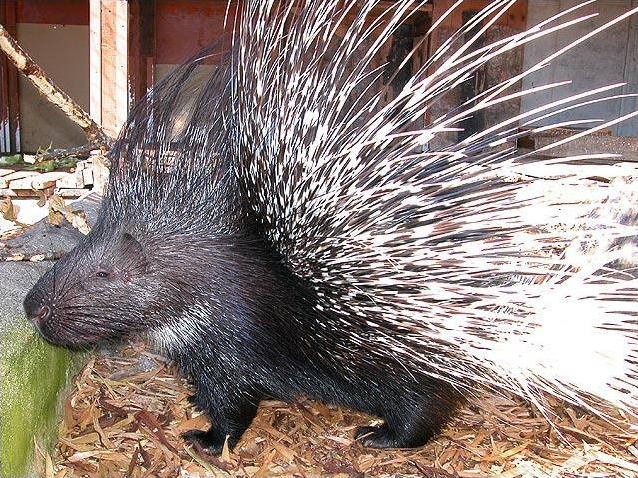
Crested porcupine, orNorth African crested porcupine(Hystrix cristata)
Phylum —chordata
Class — mammalia
Order — rodentia
Family — hystricidae
Genus – hystrix
Appearance
The adult Crested porcupine has an average head and body length around 60 to 83 cm (24 to 33 in) long, discounting the tail, and weighs from 13 to 27 kg (29 to 60 lb).
Almost the entire body is covered with bristles which are either dark brown or black and rather coarse. This mammal is recognizable by the quills that run along the head, nape, and back that can be raised into a crest. Also, some sturdier quills which are about 35 cm (14 in) in length run along the sides and back half of the body. These sturdier quills are used, for the most part, for defense and are usually marked with light and dark bands which alternate; these are not firmly attached. This porcupine has a shorter tail which has rattle quills at the end. The rattle quills broaden at the terminal end and the broad portion is hollow with thin walls. When these quills are vibrated, they produce a hiss-like rattle.
Habitat
These rodents inhabit forests, rocky and mountainous areas, croplands and sandhill deserts of Italy, Sicily and the Mediterranean coast of Africa up to northern Zaire and Tanzania.
Behavior
As nocturnal animals, the Crested porcupines spend their daytime hours in dens, coming out to forage by night. They are solitary foragers, taking long trips of up to 15 km each night. Meanwhile, these rodents are social animals, forming small family units of an adult pair and their offspring. These families live in complex burrow systems, where they spend their winter months without hibernating. Their quills are the primary mean of self-defense: when the animal is disturbed or threatened, the quills raise and vibrate, making the porcupine look larger than it is. If this action doesn't work, it will stamp its feet, vibrate its quills, attacking the opponent back first in order to stab the rival with thicker and shorter quills on its back end.
Diet
These herbivorous (lignivorous) rodents mainly consume bark, roots, tubers, rhizomes, bulbs, fallen fruits and cultivated crops, complementing their diet with insects and small vertebrates.
Reproduction
The Crested porcupines are monogamous animals, forming long-lasting pairs. They mate in November-December. Gestation period lasts for 112 days, yielding 1 - 2 well-developed babies. The young are born in a special chamber, located in their burrow system and lined with grass. Within the first week of their lives, young porcupines begin to venture from the den, by which time their spines start hardening. During the first 2 - 3 weeks, they feed upon maternal milk, until they include solid food in their diet. Sexual maturity is reached before getting the adult weight, within 1 - 2 years old.
Lifespan of this animals 15-20 years.
In captivity
In captivity, porcupines easily become tamed, although sometimes they remain timid and shake their quills in fright. Although porcupines are considered to be nocturnal animals, but in captivity they will walk in the enclosure during the day.
The enclosure must be strong. Porcupine will turn any wooden and plastic products into dust. The bottom of the enclosure should be concrete, or sheathed with metal mesh. In the aviary, you need to install a shelter (a burrow, a booth).
In their diet, porcupines differ little from the usual domestic rabbit: pellets for rodents, fruits, vegetables. Most of them like apples, carrots, Jerusalem artichoke. It is necessary to add branches of fruit trees, vitamins, minerals (chalk), as well as dry dog food, as a source of protein.
 Russian
Russian
 English
English























